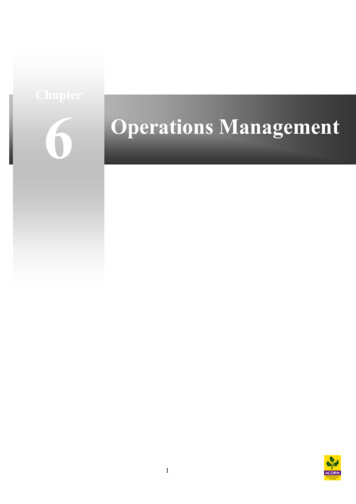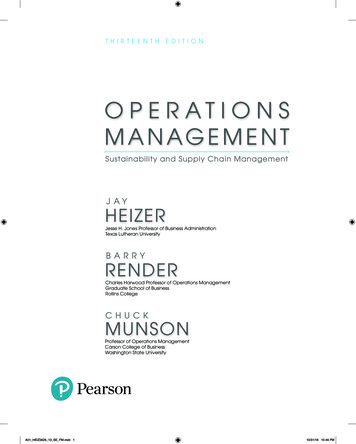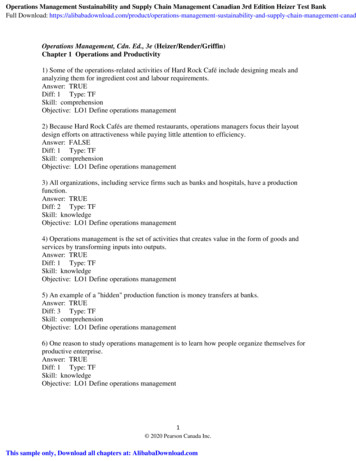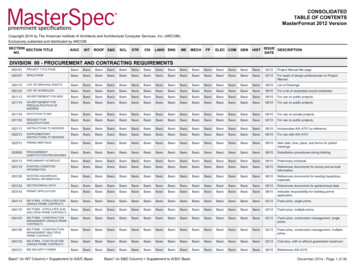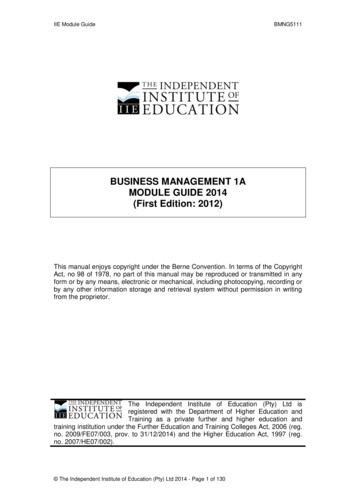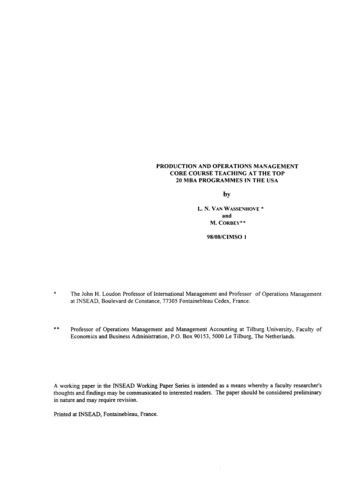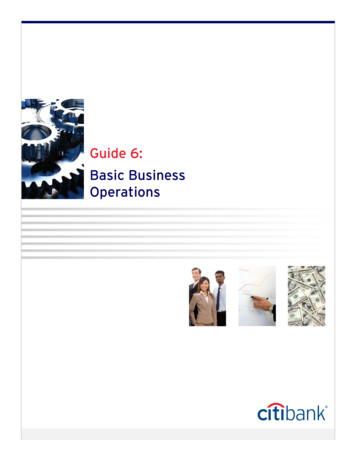
Transcription
Guide 6:Basic BusinessOperations
Guide 6: Basic Business Operationsfor the Entrepreneurn INTRODUCTIONWelcome to the Citibank Small Business information guide series. This is one of tenguides that have been developed just for you, a person who is thinking about starting asmall business or who has made the commitment to start one. It is targeted to peoplewho are considering starting a small business as well as small business owners who wantto learn more about successful strategies and skills. Citibank worked with a team ofentrepreneurs like you to develop, write, and produce this series. All of us know howimportant it is to have clear and concise information to make smart business decisions.Our goal is to share experiences about the dynamic, exciting small business community.Sound operationaldecisions are partof a successfulbusiness formula.n OverviewEveryone who starts an entrepreneurial venture wants to be successful. However,success does not happen overnight, and it is not guaranteed. A major theme throughoutthis series of guides is making the right decisions for your business. This guide providesinformation and many of the tools for you to make the operational decisions – decisionsabout the daily activities of a business - toward establishing a successful businessformula. The focus of this guide will include the following five topics. Business Legal Structure Business Physical Operations Business Regulations and Guidelines Business Financial Operations Day-to-Day Operations ManagementThere is a lot to know about the operations of a business, and this guide covers a lot ofinformation. Go through this guide at your own pace and give yourself enough time toabsorb the information.Guide 6: Basic Business Operationspage
I. Business Legal StructureWhen deciding to establish a business venture, the first decision you need to makerelates to the legal structure of the business – in other words, what kind of business areyou going to legally establish? The basic legal structures include the following. Sole Proprietorship Partnership (General or Limited) Corporation (C and S) Limited Liability Company (LLC)Each of these business structures has advantages and disadvantages. The right choice foryou should match the purpose of your business and any related tax and liability issues.You will see the terms “legal liability” (both “limited” and “unlimited”) throughoutthis guide. It is important to understand and accept your liability, or legal financialWeigh the prosand cons of eachbusiness legalstructure carefullybefore choosing.responsibility, when you start a business. Limited liability, as in stockholders of acorporation, owners of LLCs, or limited partners in a limited partnership, generallymeans that you are responsible (liable) only for the amount that you have investedinto your company. If you should encounter financial problems in your company,you lose what you have invested, but your personal assets are not included, such ashome, car, etc. There are exceptions to this general rule, which you should discuss withyour attorney. However, unlimited liability, as in a single proprietorship or generalpartnership, means there is no distinction between business and personal responsibilities.If you should encounter financial problems and have unlimited liability, your personalassets could be taken from you and used to pay back the debts of the business.Protecting your personal and business assets against a lawsuit is a primary reason tocarefully consider the legal structure of business.There are many laws and regulations that apply to small business owners; therefore, itwould be wise to consult with an attorney or CPA (Certified Public Accountant) tofully understand your legal responsibilities. The following chart provides an overview ofthe six types of legal structures for businesses. For additional background on these typesof businesses, visit http://www.sba.gov/starting business/legal/forms.htmlGuide 6: Basic Business Operationspage
Types of Business entsTaxManagementSoleProprietorshipOne ownerUnlimitedpersonalliability forobligations ofthe businessNone but DBACertificate(doing businessas) may beneededBusiness nottaxed. Ownertaxed onprofits andlosses.OwnerGeneralPartnershipUnlimitednumberof generalpartnersUnlimitedpersonalliability forobligations ofthe businessNone butGeneralPartnershipAgreementmay be neededto set forthpartner dutiesBusiness nottaxed. Profitsand losses arepassed throughto partners.Partnershave equalmanagementrights unlessthey raland limitedpartnersUnlimitedpersonalliability ofthe generalpartners;liability forlimited partnersis generallybased onthe amountinvested.Certificateof LimitedPartnershipBusiness nottaxed. Profitsand losses arepassed throughto partners.GeneralPartnermanages thebusiness,subject tothe LimitedPartnershipAgreement.Unlimitednumber ofshareholdersLimited liabilityArticles ofIncorporationTax onearnings atcorporate levelBoard ofDirectorshas overallresponsibilitywith officershaving theday-to-dayresponsibility.Limited– up to 75shareholdersLimited liabilityBusinessnot usuallytaxed. Profitsand lossesare passedthrough to theshareholders.Board ofDirectorshas overallresponsibilitywith officershaving theday-to-dayresponsibility.Business nottaxed. Profitsand losses arepassed throughto owners.Established bythe tionLimitedPartnershipAgreementBylawsArticles ofIncorporationBylawsIRS & State SCorporationElectionLimitedLiabilityCompany (LLC)Unlimitednumber ofmembersLimited liabilityArticles ofOrganizationOperatingAgreementFor purposes of this Guide, the focus will be Sole Proprietorships, Partnerships, andLimited Liability Companies (LLC). Let’s review a few highlights of the targetedbusiness structures.Guide 6: Basic Business Operationspage
Sole ProprietorshipThis is the simplest form of organization and probably the most common,mostly due to the fact that it is easiest to form and requires the least amountof legal regulation. The term “regulation” is another word for laws, rules, orguidelines. Usually, a registration (Doing Business As (DBA) Certificate)secured from the City or County Clerk’s Office is all that is required. Becausethe sole proprietorship has unlimited liability, all profits and losses belong tothe owner. As long as the profits do not exceed a certain amount, there is a taxadvantage because the income is taxed at the personal income level. However, amajor challenge might be in success itself. With expanded growth and financialsuccess, the process of operating a sole proprietorship can become challenging.When we think of sole proprietorships, we usually think of small businesses,Many smallbusinessesbegin as soleproprietorships.such as retail food stores, drug stores, restaurants, hair salons; places usuallyfound in our local neighborhoods.PartnershipA partnership is an arrangement where a small number of individuals own thebusiness. Think about whether you prefer to go into business on your own orwith one or more partners. In both types of partnerships, general and limited,there is unlimited liability for the debts of the business; however, the limitedpartner is generally responsible only for the amount invested in the business.There are certainly advantages and disadvantages for establishing a partnership,especially in the financial and management aspects of the business. Partnershipsshould always be established through formal, written contracts.When we think of partnerships, it is usually a situation where someone hashad a sole proprietorship and then decides to expand to have other partnersinvolved. It may also be a situation where two people decide to join forces inbusiness to combine their skills and financial resources.Guide 6: Basic Business Operationspage
Limited Liability Company (LLC)Limited liability companies (LLC), allowed by state statute, are becomingmore and more popular. They combine the personal liability protection of acorporation with the tax benefits and simplicity of a partnership. The LLCis a separate and distinct business operation allowing it to obtain a tax IDnumber, open a bank account, and conduct business, all under its own name.The primary advantage is that the owners are not personally liable for thedebts and liabilities of the LLC. A LLC with employees requires payroll taxesand unemployment insurance. The requirements for formation of a LLC andannual fees vary from state to state so be sure to learn about your state’s currentregulations and procedures.An LLC is commonly a small business where the owner has decided toWhen starting abusiness, considerall structureoptions with care.structure it as an LLC rather than as a sole proprietorship, in order to benefitfrom the limited liability condition.We should emphasize that no one can point to any one type of business organizationas the “best” for any given situation. All sizes and legal structures have advantagesand disadvantages. When you decide to start a business, think carefully about all theoptions and then determine which would be best for you.II. Business Physical OperationsActivity: Review the business structure chart on page 3 and think of thepurpose of your business. Answer the following questions. What level of risk am I willing to accept? Of the six options, which structure would be best for my business? What are the advantages in choosing this option? What are the disadvantages in choosing this option?Guide 6: Basic Business Operationspage
Once you have established the legal structure for your business, you need to thinkabout the physical operations of the business. Business operations include the locationof your business and the processes, resources, and other tools you will need totransform inputs (raw materials, labor, and capital) into outputs (goods or services). Tomaximize your outputs for profitability, you must organize your inputs. While somebusinesses have unique physical operational needs, there are basic areas for all businessowners to consider. The operational decisions you make can improve the efficiency(and profit line) of your end product. There is no one right design for a business’sphysical operations; it depends on the product (good or service) and the productionprocess. As a business owner, it is essential to make certain that all operations functionwell and integrate with one another effectively. Location and FacilityWhich of the following physical operations do you need to consider for yourThough eachbusiness isunique, they canshare many basiccharacteristics.business?Worksheet: Do the MathIf I choose to have a building that currently exists, what would be the annualcost for me to obtain the facility I need under the following options? Annual cost to rent? Annual cost to lease? Annual cost to buy?Based on my current financial standing, which of theabove options would be the best financial businessdecision for me?Guide 6: Basic Business Operationspage
Should I lease or buy my physical facility? Should I build a new facility orbuy an existing one? Where should I locate my business to reach the greatestnumber of customers and to provide efficient access to employees and vendors?Factors such as visibility, traffic flow, parking, and tenant compatibility arealso important. You will need to consider many factors such as square footage,layout, utilities, storage, etc. Location may be critical even if you are planning ahome-based business.When making the decision to lease, to buy an existing facility, or to build anew facility, consider your goals and the desired end result. Would it be betterto lease (or rent) an existing facility so you would not be tied to a location andtherefore, able to move as your business expands? Or, would you want to finda facility large enough to house your existing business, with room to expandin the future? Also, consider that when leasing, many owners “remodel to suitEven if yourbusiness is smallnow, it’s a goodidea to plan forexpansion.your needs,” potentially saving you money. Operational / Production Equipment and MaintenanceShould I lease or buy my office equipment? If I do lease, should I lease all ofthe equipment or only certain pieces? Along with the equipment, how shouldI manage the maintenance? Which is more cost effective – buying or leasing?What are the advantages and disadvantages of each? To help you answer thesequestions, visit m htm EmployeesIf I need employees, how many and in what job functions? Should I hire theemployees full-time, part-time, or on an “as needed” basis? Do I need a salesforce? What are the advantages and disadvantages of the various options? Professional AssistanceEven if you determine that you don’t need employees, you may sometimesneed outside expertise to help you meet your business goals. With a smallGuide 6: Basic Business Operationspage
business, especially a new business, many of the basic day-to-day operations canbecome overwhelming and sometimes keep you from focusing on the biggerpicture. Think about the most cost-effective way to use your time and talents.Then, ask yourself what outside professional services you might help you tobe more successful and your business more profitable. When full-time andeven part-time assistance is prohibitive, you can still build an infrastructure ofprofessionals to assist you – with the advantage of not having fixed overhead.Remember that financial institutions like Citibank provide professionalassistance in organizing the financial part of your business. These professionalscan help you with setting up your payroll service, processing tax payments, aswell as other important functions in your business.When considering professional assistance, identify the key operational functions youwill need in your business. Do you need help with accounting and bookkeeping?Many businessesrely on otherbusinesses forexpertise andassistance.Have you identified an attorney to work with? The decision may be to contract witha company rather than an individual. Either way, treat these contractual agreementsjust as you would in hiring employees. Interview the candidates, ask questions, discussfees and services, and consider giving them a small assignment so that you can sampletheir services before you engage in a long-term relationship. When identifying the rightcombination of services, don’t let price be the only factor in your decision. Higherprices are not always a guarantee of better service, and lower prices do not always meana lower level of service. Experience and expertise is usually a winning combination.Take the time to think about why you need these professionals and do not hesitate toseek their assistance and expertise.Guide 6: Basic Business Operationspage
ActivityThink of your proposed business. For each of the categories listed, summarize yourinitial plans for each, based on the end-product.Physical OperationsApplies to mybusiness? (yes/no)If yes, what are myneeds?Location and FacilityOperational Equipmentand MaintenanceProduction Equipmentand MaterialsEmployeesProfessionalAssistanceAdditional Physical Operations Questions to Consider: What are the industry standards in each of these areas? Does the industry standard align with my business goals?III. Business Regulations and GuidelinesThere are laws and regulatory requirements that affect every aspect of your businessventure. While it might be frustrating to deal with the many regulations, most existfor the protection of your business venture. Many of the regulatory requirements existat multiple levels -- local, state, and federal. Don’t hesitate to consult with appropriateprofessionals who will listen to your business plan and provide you with the expertiseand guidance you need. Remember: It is your legal responsibility to be aware of theguidelines and any changes in taxes and regulations.Guide 6: Basic Business Operationspage 10
Because it would be impossible to list every law and regulation in this Guide, we willhighlight the critical categories of business formation, taxes, intellectual property, legaldocuments, and insurance.Business FormationThere are many regulations that are applicable to small business owners. It is best toconsult an attorney or CPA to determine to the full range of requirements. The basichighlights include the following. Federal GovernmentEmployer Identification Number (EIN) () – Form SS-4No matter what legal structure your business takes, taxes will exist. In orderto receive credit for tax payments, you must have a business identificationnumber, known as an Employer Identification Number. Issued by theInternal Revenue Service (IRS), you will need to include your EIN onall tax returns and any other documentation you send to the IRS. Toreceive an EIN, obtain and file IRS Form SS-4, Application for EmployerIdentification Number. The application, along with the filing process,is available from your local IRS office or online at http://www.irs.gov/businesses/small/article/0,,id 99194,00.htmlEmployment Verification – Form I-9If you have employees, you will need to complete Form I-9 – EmploymentVerification Form – issued by the U.S. Customs and Immigration Service.As an employer, you are responsible for verifying that each employee iseligible to work in the United States. The form is available from the U. S.Customs and Immigration Service, the local IRS, or online at http://www.irs.gov/businesses/small/article/0,,id 99194,00.htmlGuide 6: Basic Business Operationspage 11
State GovernmentYou can go to a Secretary of State website for all state business requirements.(i.e., http://sos.state.TX.us/) Remember to insert your two- letter state postalcode identification in place of the “TX” example used in the website above.Business RegistrationTo register to conduct business in a state, you should contact the (state)Secretary of State for a Business Registration Form. There is usually aminimal fee for the registration, and it is renewed each year.Sales Tax LicenseIf you sell retail products and your state imposes sales tax on these products,you are responsible for obtaining a sales tax license. The application andfurther instructions can be obtained from the (state) Department ofFiling for permitsand licenses is animportant stepin making yourbusiness legal.Revenue.Articles of Organization (LLC Business Structure)If your business structure is a LLC (Limited Liability Company), you willneed to complete and file the Articles of Organization with the (state)Secretary of State. There is usually a minimal fee for the filing process. Local Government (City and County)Business RegistrationSole proprietorships and general partnerships operating under an assumedname should apply for a DBA (Doing Business As) Certificate. This isusually a one-time occurrence. The City and County Clerk’s office canadvise you on these regulations.Permits and LicensesWill your business require zoning, health permits, or environmentalapprovals to operate? The regulatory requirements depend on the structureGuide 6: Basic Business Operationspage 12
of the business, the location, and/or the product or service you areoffering. An attorney or CPA will be able to provide the requirementsfor business licenses, as well as building codes and permits, zoning laws,health department requirements, and environmental laws. You will needto successfully complete all requirements before opening your business.Contact the City and County Clerk’s Office where you will be doingbusiness to determine your permit and license requirements.TaxesThe legal structure of the business, along with the product or service you offer,determines what taxes you must pay and how you pay them. Among these taxes areincome tax, self-employment tax, employment tax, sales tax, and excise tax. With eachof the following categories, the IRS web site is a central repository for appropriate taxBusinesses aresubject to severaldifferent kinds oftaxes.forms. See http://www.irs.gov/businesses/small/article/0,,id 99194,00.html. Income TaxAll businesses file an annual income tax return with the IRS – and possiblywith the state(s) where the business operates. Most businesses file a quarterlyEstimated Tax Payment (Form 941) during the year, meaning they depositestimated tax payments as they go and reconcile any differences on their annualtax returns. Employment Tax (Payroll Taxes)Under the Federal Insurance Contributions Act (FICA), as of 2005, 12.4percent of any earned income up to an annual limit must be paid into SocialSecurity, and an additional 2.9 percent must be paid into Medicare. If youhave employees, you will need to collect and deposit employment taxes fromtheir wages/salaries, as well as your employer’s share. Form W-4, Employee’sWithholding Allowance Certificate, issued by the Internal Revenue Serviceand completed by all employees, allows employers to determine the amountof employment taxes to withhold from the employee’s wages. As an employer,deposits are made on a quarterly basis with the IRS and the (state) DepartmentGuide 6: Basic Business Operationspage 13
of Revenue. Also included in this category of tax payments are the employer’scontributions toward the state unemployment tax – Form 940. Self-Employment TaxIf you are self-employed, you will be responsible for paying the full extent ofFICA and other employment taxes, as noted in the above paragraph. Sales Tax Reports and PaymentsIf your business sells retail products and your state imposes sales tax onproducts, then you are responsible for collecting and paying that tax. Thetax is computed on the product’s sale price. The sales tax you collect must beforwarded to the state, either on a monthly or quarterly basis, depending onthe volume of your sales. Check with your (state) Department of Revenue todetermine appropriate requirements and payment process. Sales tax paidby a businessvaries dependingon where it islocated.Excise TaxIf you manufacture or sell certain products, operate certain types of businesses,or use certain types of equipment, facilities, or products, you may be requiredto pay excise taxes. For a current list of those categories, check with your localIRS office.For help on tax questions, check out the following resources. Small Business Tax Education Program – Workshops provided by partnershipsbetween local organizations and the IRS. Check with your local IRS office. IRS Questions, Tax Forms, and Publications – Variety of helpful informationfrom your local IRS office or online at http://www.irs.gov Small Business Administration – Variety of services to small business ownersincluding training, educational programs, counseling, etc. Contact your localSBA office or visit http://www.sba.orgGuide 6: Basic Business Operationspage 14
Intellectual PropertyNo matter the type of business, all businesses have “intellectual property.” Manybusiness owners overlook this management area until it is too late. The term intellectualproperty covers a broad spectrum of rights related to inventions, trade secrets, creativeworks along with patents, trademarks, copyrights, etc. From the very beginning stagesof the business, you need to take the proper measures to protect all forms of yourbusiness intellectual property. These actions can be as formal and legal as obtainingcopyrights, trademarks, etc. or as simple as limiting access to certain materials andinformation or marking items as “Confidential.” Although an attorney is not required,it is recommended, and professional legal assistance can help you preserve yourintellectual property rights.The purpose of protecting your intellectual property has a dual impact. You also needto be sure that you do not infringe on the intellectual property of others. Be careful toIt is importantto protect youroriginal ideaswith patents andcopyrights.ensure that employees do not decide to leave your company and take your ideas withthem. PatentsThe best protection you can get for a new product or process is a patent. Apatent gives its originator the right to prevent others from making, using, orselling the patented product or process. To qualify for patent protection, aproduct does not have to be new. It can be an improvement on an existingproduct or process. Be sure to check out the conditions under which you canapply for and receive a patent at the U. S. Patent and Trademark Office athttp://www.uspto.gov. You can do an initial search to determine if a patentalready exists. TrademarksA trademark protects the symbolic value of your product – your brand. Atrademark can be a name, symbol, device (or a combination) that is used toidentify or distinguish the product from others. You can establish a trademarkby simply using the symbol, but it is best to have federal registration ( ) of theGuide 6: Basic Business Operationspage 15
trademark should you ever need legal action. To register, complete the necessaryforms with the U. S. Patent and Trademark Office. There is a fee. If granted,the trademark is protected initially for 10 years. Check out http://www.uspto.gov/ for a quick search to see if your proposed name, symbol, device, etc.infringes upon existing trademarks and to get more details. CopyrightsNo matter what you produce, you are entitled to protection under copyrightlaws. You can copyright items such as art, books, music, jewelry, software,advertisements, etc. A copyright rests with either the person who actuallycreates the work or with the employer, if the work is created “within thescope of an employee’s employment.” All employees should sign a CopyrightAgreement, and any independent contractor should sign an IndependentContractor Agreement that usually contains a “work for hire” clause. Also, itIntellectualproperty can beas valuable asphysical property- guard it well.would be beneficial for you to get legal advice on these matters as well. Confidentiality AgreementsYour intellectual property can make or break the success of your business.When you are working with tangible items, it is much easier to obtain acopyright, patent, or trademark — but what about protecting your creativeideas? Your ideas are very important and should be protected as well. So, becareful with whom you talk and how you share your business ideas. If theideas are important enough, it is best to have all parties sign a ConfidentialityAgreement. As a business owner, you have the right to take action againstanyone who breaches an agreement, a confidential relationship, or comprisesyour confidential business information.Legal DocumentsEvery business, large or small, has legal paperwork that tracks and documents theactivity of the business. These documents include contracts, sales agreements, leases,purchase orders, service agreements, etc. The right type of document will serve as aGuide 6: Basic Business Operationspage 16
valuable and legal representation of your business activity. When deciding which legaldocuments are needed, become familiar with the industry standards in your business.Let’s review a few types of legal documents that you may need in your business venture. ContractsA contract is an agreement between parties, with terms and conditions thatconstitute a legal obligation of all parties involved. There are many templatesfor you to use as a reference when developing a contract but remember thateach contract must be unique to the situation. Contracts can vary from preprinted forms to oral contracts to e-mail contracts. However, your best defenseis to have a well-written, signed contract. When done correctly, contracts areyour best defense when conflicts with employees, suppliers, or customers arise.While every contractual circumstance is different, every contract should havesome or all of the following components. Checklist: Critical Contract Components Identification of parties. Complete names, addresses, etc. for allparties. Contract Background. All critical information about the project andany key assumptions. Obligations. What each party will do and by what date, etc. Contract Terms. The length and renewal or extension process, ifnecessary. Price. Not only the amount of money to be exchanged but how theprice was determined. Payment Process. When the payment is due and how it will be paid(installment or one lump sum), etc. Warranties. Under what conditions the product will be delivered, etc. Liability. Conditions surrounding the end product.Guide 6: Basic Business Operationspage 17
Contract Termination. When the contract will end and whathappens if one of the contract parties has to terminate early, etc. Confidentiality. Which party may publicize the project, etc. LeasesLeases outline the rules and regulations that allow a landlord to provide,maintain, and operate a facility or equipment. In exchange for the agreement,you receive access to the facilities and/or equipment. As with all contracts, itis critical to read carefully before signing, as leases can make you accountablefor many things. The best lease is a written lease that clearly sets out theresponsibilities and terms for both parties and is easily referenced whenquestions come up. Sales contractsInsurance is acritical aspect ofprotecting yourinvestment in yourbusiness.The sales contract defines the price, terms, and conditions of the sale of services,equipment, or other products. A sales contract can vary from the fine printfound at the bottom of a sales ticket to a document tailored to the specific sale.To establish your business, your sales contracts should represent your business,have a standardized look, and represent something that is non-negotiable.InsuranceInsurance is defined as protection against risks. And there are many risks associatedwith starting a business. To protect your business and yourself, consider the followingins
and disadvantages. When you decide to start a business, think carefully about all the options and then determine which would be best for you. II. Business Physical Operations When starting a business, consider all structure options with care. Activity: Review the business structure chart on page an
